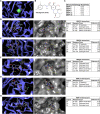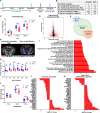Dolutegravir Inhibition of Matrix Metalloproteinases Affects Mouse Neurodevelopment
- PMID: 34390469
- PMCID: PMC8599359
- DOI: 10.1007/s12035-021-02508-5
Dolutegravir Inhibition of Matrix Metalloproteinases Affects Mouse Neurodevelopment
Abstract
Dolutegravir (DTG) is a first-line antiretroviral drug (ARV) used in combination therapy for the treatment of human immunodeficiency virus type-1 (HIV-1) infection. The drug is effective, safe, and well tolerated. Nonetheless, concerns have recently emerged for its usage in pregnant women or those of child-bearing age. Notably, DTG-based ARV regimens have been linked to birth defects seen as a consequence of periconceptional usages. To this end, uncovering an underlying mechanism for DTG-associated adverse fetal development outcomes has gained clinical and basic research interest. We now report that DTG inhibits matrix metalloproteinases (MMPs) activities that could affect fetal neurodevelopment. DTG is a broad-spectrum MMPs inhibitor and binds to Zn++ at the enzyme's catalytic domain. Studies performed in pregnant mice show that DTG readily reaches the fetal central nervous system during gestation and inhibits MMP activity. Postnatal screenings of brain health in mice pups identified neuroinflammation and neuronal impairment. These abnormalities persist as a consequence of in utero DTG exposure. We conclude that DTG inhibition of MMPs activities during gestation has the potential to affect prenatal and postnatal neurodevelopment.
Keywords: Antiretroviral drug; Dolutegravir; HIV-1; Matrix metalloproteinases; Neurodevelopment; Pregnancy outcomes.
© 2021. The Author(s).
Conflict of interest statement
Drs. Benson Edagwa and Howard E. Gendelman are co-founders of Exavir Therapeutics, Inc., a biotechnology company focused on the development of long-acting antiretroviral medicines. The remaining authors declare that they have no competing interests.
Figures





References
-
- World Health Organization (2016) Consolidated guidelines on the use of antiretroviral drugs for treating and preventing HIV infection: recommendations for a public health approach—second edition. https://www.who.int/hiv/pub/arv/chapter4.pdf?ua=1. Accessed February 27 2021 - PubMed
-
- Crowell CS, Williams PL, Yildirim C, Van Dyke RB, Smith R, Chadwick EG, Seage GR, 3rd, Diperna A, Hazra R, Pediatric HIVACS. Safety of in-utero antiretroviral exposure: neurologic outcomes in children who are HIV-exposed but uninfected. AIDS. 2020;34(9):1377–1387. doi: 10.1097/QAD.0000000000002550. - DOI - PMC - PubMed
-
- Department of Health and Human Services (DHHS), Panel on Antiretroviral Guidelines for Adults and Adolescents. Guidelines for the use of antiretroviral agents in adults and adolescents living with HIV. https://clinicalinfo.hiv.gov/sites/default/files/guidelines/documents/Ad.... Accessed June 11 2021
MeSH terms
Substances
Grants and funding
- R01 NS036126/NS/NINDS NIH HHS/United States
- R01 MH115860/MH/NIMH NIH HHS/United States
- R01AI145542/NH/NIH HHS/United States
- R01 AI145542/AI/NIAID NIH HHS/United States
- P01 DA028555/DA/NIDA NIH HHS/United States
- R01 AI158160/AI/NIAID NIH HHS/United States
- P01 DA028555-09S1/NH/NIH HHS/United States
- R01 MH115860/NH/NIH HHS/United States
- 2R01 NS034239/NH/NIH HHS/United States
- R01 AI158160/NH/NIH HHS/United States
- P30 MH062261/NH/NIH HHS/United States
- R01 MH121402/NH/NIH HHS/United States
- R01 NS36126/NH/NIH HHS/United States
- P01 DA028555/NH/NIH HHS/United States
- R01 MH121402/MH/NIMH NIH HHS/United States
LinkOut - more resources
Full Text Sources
Medical

